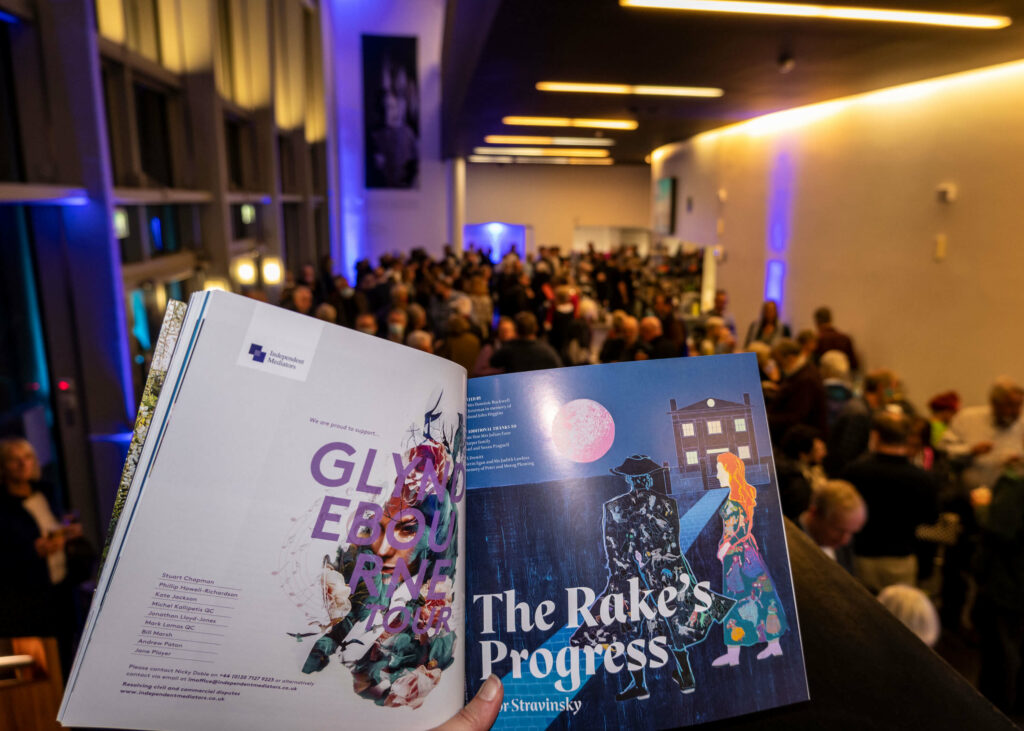Two years ago I was fortunate enough to watch an opera for the very first time, when East Sussex-based opera house Glyndebourne spent a week at the Marlowe Theatre as part of their national tour. The company performed three operas at the theatre during their time in Canterbury and I was in the audience on the very first night, witnessing Glyndebourne’s interpretation of Donizetti’s L’elisir d’amore. This year Glyndebourne are back in Canterbury once again, performing three completely different operas for local crowds. Starting with The Rake’s Progress yesterday evening, Glyndebourne are at the Marlowe until Friday 5th November covering Messiah and Don Pasquale on the final two nights. That first experience has stuck with me ever since, thanks to the phenomenal vocals and the way Glyndebourne totally transformed the Marlowe stage and orchestral pit to magnify the operatic sound.
Last week a Marlowe press night invitation for The Rake’s Progress dropped into my inbox and I was so excited to have the opportunity to go back to the opera. Yesterday evening my mother-in-law and I arrived at The Marlowe Theatre, ready for an evening of spectacular music and drama. I couldn’t wait to see how Glyndebourne’s production crew had adapted the theatre for their three performances this year and experience a night at the opera again.

Origins and plot
Igor Stravinsky’s The Rake’s Progress debuted in 1951 and follows the misfortunes of Tom Rakewell: a young man who is easily led astray by the promise of a fortune. Stravinsky was inspired by Hogarth’s 18th-century painting series ‘A Rake’s Progress’ and Tom Rakewell’s life follows the same direction as Hogarth’s ill-fated subject of the same name.
Tom initially lives in the countryside and is pursuing local girl Anne Trulove. However things dramatically change when the character Nick Shadow turns up at his door and entices Tom to the big city. City life is not quite what Tom expected and it consists of brothels, a bearded lady and business mishaps, all thanks to Nick Shadow’s encouragement. After an unfortunate time in the city, Tom Rakewell later realises that he shouldn’t have abandoned his countryside life with Anne and like most stories with morals there are consequences for his rash actions.
Music
This year Glyndebourne once again transformed the front of the Marlowe auditorium, extending the orchestral pit into the first few lines of the stalls and allowing the distinct operatic sound to reach every corner of the theatre. The principle characters’ voices blended brilliantly with the instruments. Each piece of music showcased a performer’s impressive vocal range but not to the point where the instrumental was overpowered.
Anne Trulove’s soprano vocals were hauntingly beautiful. Every time she had a solo section the audience was drawn to her gentle interpretation of the melody and lyrics. It was a real contrast to the solo numbers sung by Nick Shadow, whose vocals needed to show strength and help amplify the drama and dark sides of the production. Despite impressive performances from the lead characters, the Glyndebourne Chorus stole the show for me. All of those pitch perfect voices coming together created such a rich wall of sound!

Sets, staging and costumes
Yorkshire artist David Hockney was the creative genius behind the sets, staging and costumes, with Glyndebourne continuing to use his designs from their original 1975 version of the opera. The backdrops were so unique and unlike anything I’d seen before, containing drawings of various geometric shapes and lines, lots of architectural detail and a series of 18th-century figures. The chorus costumes had also been carefully selected to align with the backgrounds, creating visual harmony on stage. I can totally see why Glyndebourne continues to use Hockney’s amazing designs.
However, such dramatic and impressive sets meant that there were regular short pauses in the production to allow for scene changes. This did make it a little difficult to focus on the plot in the first half of the opera when the story was building. The scenes in the second half were much easier to follow as the plot amplified and I was more prepared for the pauses.

Overall thoughts
Although quite long at 3 hours and 15 minutes (including a short interval), I was thoroughly impressed by the performance. The music was brilliant as always and David Hockney’s sets really made the staging stand out. It was also quite funny and I hadn’t expected to laugh as much as I did.
In order to be able to produce such a spectacular production and take it on the road, the cast and crew must have spent so much time in rehearsals. If yesterday’s performance is anything to go by, audiences seeing the remaining two operas at the Marlowe are in for a real treat. There is still time to purchase tickets for Don Pasquale via the theatre’s website. I am hugely grateful for the opportunity to review one of Glyndebourne’s operas again*.
Thanks for reading my blog today.
Love Kat xxxx
*Our tickets and programme for The Rake’s Progress were gifted in exchange for a review of the performance.

Comments